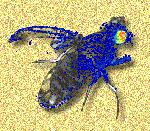How Biological Clocks Work
 Anyone who has traveled has experienced jet lag—that groggy realization that while your day is beginning in Washington, DC, the night you just left in San Francisco is hardly over. Jet lag is an inconvenient reminder that the body is set to a 24-hour clock, known by scientists as circadian rhythms, from the Latin circa dies, 'about one day.' An internal biological clock is fundamental to all living organisms, influencing hormones that play a role in sleep and wakefulness, metabolic rate, and body temperature. Disruption of circadian rhythms not only affects sleep patterns but also has been found to precipitate mania in people with bipolar disorder (manic-depressive illness). Other types of illnesses also are affected by circadian rhythms; for example, heart attacks occur more frequently in the morning while asthma attacks occur more often at night.
Anyone who has traveled has experienced jet lag—that groggy realization that while your day is beginning in Washington, DC, the night you just left in San Francisco is hardly over. Jet lag is an inconvenient reminder that the body is set to a 24-hour clock, known by scientists as circadian rhythms, from the Latin circa dies, 'about one day.' An internal biological clock is fundamental to all living organisms, influencing hormones that play a role in sleep and wakefulness, metabolic rate, and body temperature. Disruption of circadian rhythms not only affects sleep patterns but also has been found to precipitate mania in people with bipolar disorder (manic-depressive illness). Other types of illnesses also are affected by circadian rhythms; for example, heart attacks occur more frequently in the morning while asthma attacks occur more often at night.
Although biological clocks have been the focus of intensive research over the past four decades, only recently have the tools needed to examine the molecular basis of circadian rhythms become available. Early studies pointed to an area of the brain, the hypothalamus, as the location of the circadian pacemaker in mammals. More recent findings show proteins called cryptochromes, located throughout the body, are also involved in detecting changes in light and setting the body's clock. Genes that code for the clock protein, PER, glow in the head and other body parts of a fruit fly. Researchers made the clocks glow by engineering transgenic strains of flies in which the same genes that illuminate a jellyfish and a firefly's tail are attached to PER.
The gene for luciferase, the enzyme that glows intermittently in fireflies, was expressed along with PER to reveal when the clock protein was being produced. Flies were also molecularly altered to brightly mark the clock sites with Green Fluorescent Protein, which glows constantly in jellyfish. The first circadian gene was discovered in 1971 in the fruit fly; a second circadian gene was detected 13 years later. Following these discoveries, however, the search for clock genes in other organisms faltered. Not until 1997 was the first circadian gene found in a mammalian model, the mouse. This discovery immediately accelerated the search for other clock genes, and findings in higher order animals are yielding a consistent picture of the role and function of circadian rhythms in organisms from bacteria to plants to mammals.
About the Author
NIH NIMH
 The National Institute of Mental Health is one of 27 institutes and centers that make up the National Institutes of Health.
The National Institute of Mental Health is one of 27 institutes and centers that make up the National Institutes of Health.


